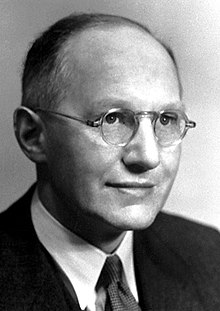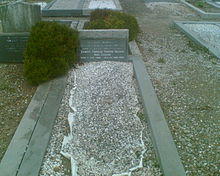Ernest Walton

Ernest Thomas Sinton Walton (born October 6, 1903 in Dungarvan , County Waterford , † June 25, 1995 in Belfast ) was an Irish physicist and Nobel Prize laureate in physics.
Life
Ernest Walton was the son of a Methodist minister. After graduating from a Methodist college in Belfast , he began studying mathematics and experimental physics at Trinity College in Dublin in 1922 and graduated from both subjects in 1926/27. He then moved on a research fellowship to the Cavendish Laboratory at Cambridge University , which was headed by Ernest Rutherford . After receiving his doctorate in 1931, he stayed in Cambridge until 1934 and then returned to Trinity College. In 1946 he was appointed professor of natural philosophy and experimental physics .
Walton married Freda Wilson, the daughter of a Methodist parish priest in 1934, and has two sons (Alan and Philip) and two daughters (Marian and Jean). He died in Belfast in 1995.
Act
Walton was already doing research in Cambridge on the acceleration of ions by means of direct voltage and also of electrons according to the betatron principle. Together with John Cockcroft , he developed the Cockcroft-Walton accelerator there . With it, conversions ( nuclear reactions ) could be triggered and detected by bombarding various light atomic nuclei with fast protons .
In 1951 Ernest Walton and John Cockcroft were awarded the Nobel Prize in Physics “for their pioneering work in the field of atomic nucleus conversion by artificially accelerated atomic particles”.
Awards
- Hughes Medal , Royal Society London , 1938
- Nobel Prize in Physics , 1951
literature
- Brian Cathcart: The Fly in the Cathedral. How a small group of Cambridge scientists won the race to split the atom. Viking, 2004, ISBN 0-670-88321-2 .
Web links
- Information from the Nobel Foundation on the 1951 award ceremony for Ernest Walton
| personal data | |
|---|---|
| SURNAME | Walton, Ernest |
| ALTERNATIVE NAMES | Walton, Ernest Thomas Sinton (full name) |
| BRIEF DESCRIPTION | Irish physicist |
| DATE OF BIRTH | October 6, 1903 |
| PLACE OF BIRTH | Dungarvan , County Waterford |
| DATE OF DEATH | June 25, 1995 |
| Place of death | Belfast |

